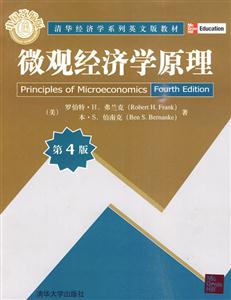-
>
豫商发展史与豫商案例研究:商圣范蠡评传
-
>
图解资本论
-
>
金融炼金术(专业珍藏版)2021专业审订
-
>
博雅丛书系列——经济行为的人文向度
-
>
新兴七国比较研究:全球化与国家竞争
-
>
协同创新网络研究
-
>
结构性改革:中国经济的问题与对策
微观经济学原理-第4版 版权信息
- ISBN:9787302223283
- 条形码:9787302223283 ; 978-7-302-22328-3
- 装帧:一般胶版纸
- 册数:暂无
- 重量:暂无
- 所属分类:>>
微观经济学原理-第4版 本书特色
《微观经济学原理(第4版)》:清华经济学系列英文版教材
微观经济学原理-第4版 内容简介
本书的一大特色是摒弃了以往教材对数学推导的过度依赖,更多地通过范例给出直观的经济学概念和观点。作者引入了一些核心原理,然后通过大量的事例给予说明并加以应用。书中还配有与这些原理相关的问题和练习题,以供学生课后练习使用。本书的另一特色是加强了对学生的经济学应用能力的培养,鼓励读者用基本的经济学原理来理解和解释发生在自己周围的一些实际问题。
作为微观经济学入门水平的教材,本书适合大专院校经济管理各相关专业使用,也可作为普通读者了解微观经济学的读物。
本书的中文翻译版已由清华大学出版社出版。
微观经济学原理-第4版 目录
第1部分 引言
第1章 像经济学家一样思考
第2章 比较优势:交换的基础
第3章 供给和需求
第2部分 竞争与看不见的手
第4章 弹性
第5章 需求
第6章 完全竞争供给
第7章 效率与交换
第8章 看不见的手
第3部分 市场失灵
第9章 垄断、寡头垄断和垄断竞争
第10章 博弈和战略行为
第11章 外部性和产权
第12章 信息经济学
术语表c—1
微观经济学原理-第4版 节选
《微观经济学原理(第4版)》的一大特色是摒弃了以往教材对数学推导的过度依赖,更多地通过范例给出直观的经济学概念和观点。作者引入了一些核心原理,然后通过大量的事例给予说明并加以应用。书中还配有与这些原理相关的问题和练习题,以供学生课后练习使用。《微观经济学原理(第4版)》的另一特色是加强了对学生的经济学应用能力的培养,鼓励读者用基本的经济学原理来理解和解释发生在自己周围的一些实际问题。作为微观经济学入门水平的教材,《微观经济学原理(第4版)》适合大专院校经济管理各相关专业使用,也可作为普通读者了解微观经济学的读物。《微观经济学原理(第4版)》的中文翻译版已由清华大学出版社出版。
微观经济学原理-第4版 相关资料
插图:Consider a society consisting only of Susan, who allocates her production time between coffee and nuts. She has nimble fingers, a quality that makes her more productive at picking coffee than at gathering nuts. She can gather 2 pounds of nuts orpick 4 pounds of coffee in an hour. If she works a total of 6 hours per day, describeher production possibilities curve——the graph that displays, for each level of nutproduction, the maximum amount of coffee that Susan can pick.The vertical axis in Figure 2.1 shows Susan's daily production of coffee and thehorizontal axis shows her daily production of nuts. Let's begin by looking at twoextreme allocations of her time. First, suppose she employs her entire workday(6 hours) picking coffee. In that case, since she can pick 4 pounds of coffee per hour,she would pick 24 pounds per day of coffee and gather zero pounds of nuts. Thatcombination of coffee and nut production is represented by point A in Figure 2.1.It is the vertical intercept of Susan's production possibilities curve.Now suppose, instead, that Susan devotes all her time to gathering nuts. Sinceshe can gather 2 pounds of nuts per hour, her total daily production would be 12pounds of nuts. That combination is represented by point D in Figure 2.1, the horizontal intercept of Susan's production possibilities curve. Because Susan's production of each good is exactly proportional to the amount of time she devotes to thatgood, the remaining points along her production possibilities curve will lie on thestraight line that joins A and D.For example, suppose that Susan devotes 4 hours each day to picking coffeeand 2 hours to gathering nuts. She will then end up with (4 hours/day) x (4 pounds/hour) = 16 pounds of coffee per day and (2 hours/day) x (2 pounds/hour) =4 pounds of nuts. This is the point labeled B in Figure 2.1. Alternatively, if shedevotes 2 hours to coffee and 4 to
微观经济学原理-第4版 作者简介
罗伯特·H.弗兰克(Robert H.Frank)美国康奈尔大学经济学、伦理学与公共政策教授,曾与他人共同著述《赢家通吃的社会》,对消费行为理论有很大影响。
- >
山海经
山海经
¥20.4¥68.0 - >
【精装绘本】画给孩子的中国神话
【精装绘本】画给孩子的中国神话
¥17.6¥55.0 - >
中国人在乌苏里边疆区:历史与人类学概述
中国人在乌苏里边疆区:历史与人类学概述
¥24.0¥48.0 - >
史学评论
史学评论
¥13.9¥42.0 - >
回忆爱玛侬
回忆爱玛侬
¥10.5¥32.8 - >
罗曼·罗兰读书随笔-精装
罗曼·罗兰读书随笔-精装
¥40.6¥58.0 - >
名家带你读鲁迅:故事新编
名家带你读鲁迅:故事新编
¥13.0¥26.0 - >
诗经-先民的歌唱
诗经-先民的歌唱
¥15.1¥39.8
-
国富论
¥15.9¥49.8 -
用辩证的眼光看市场经济
¥8.6¥20 -
经济学越简单 越实用
¥11.5¥36 -
博雅丛书系列——经济行为的人文向度
¥6¥24 -
图解资本论
¥23.5¥46 -
经济学谬误-为反资本主义者所著
¥12.7¥39.8
















